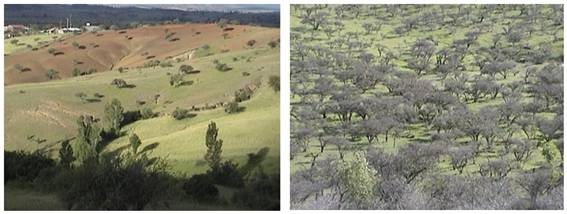Land and resource uses
The Mediterranean zone of Chile has suffered a great transformation since the colonization by the European. In the beginning of the fifteenth century, when the Spanish arrived in the Central Valley of Chile, diverse woody species (Quillaja saponaria, Peumus boldus, Maytenus boaria, Lithraea caustica, Cryptocaria alba) occurred, interspersed by landscape units managed or 'gardenified' by the indigenous inhabitants (Ovalle et al., 1990). Today, however, only very small, scattered remnants of the pre-Colombian ecosystems remain (345.324 ha; CONAF, 1997), which represent only 2% of the native forest of Chile (CONAF, 1997) and less than 10% of the original area of sclerophyllous woodlands (Lara et al., 1996).
The naturalistic value of the Mediterranean woodland is very high (Arroyo et al., 1999). A large number of species are endemic and some of them are in severe risk of extinction, like Jubaea chilensis, Beilschmiedia miersii, B. berteroana and Gomortega keule (Hoffmann, 1989 a, b; Ortiz et al. 1993).
At present, most of this 1.6 million ha area is occupied by a biologically monotonous, park-like ecosystem (espinales) dominated by a single spiny, stump-sprouting Mimosoid tree legume, Acacia caven (Mol.) Mol.(espino). The herbaceous stratum consists of a wide variety of Eurasian and other non-native annuals that have virtually replaced all native forbs and grasses in the area (Figure 5).

Figure 5: Degraded and well preserved "espinales" in Cauquenes study site area.
The formation and the tree itself yield certain products to farmers and their livestock, but soil fertility and biodiversity are all low, and livestock productivity three to four times lower, than in other agro-ecosystems in Mediterranenean climate areas of southern Europe or Australia with similar rainfall patterns (Puckridge & French, 1983; Reeves & Ewing, 1993; Ovalle et al., 2006; del Pozo et al., 2006).
Agriculture in the Chilean "secano interior" has long suffered from low inputs and dependence on a limited number of crops (cereal, livestock husbandry and viniviticulture). Cutting, burning and plough agriculture over the last four centuries have led to dramatically degraded soils and landscapes of stikingly low bio- and ecodiversity.
Over the last 40 years, the coastal foothills, as well as an increasing percentage of hillside of the "secano interior" have been sold to forestry companies who create industrial scale plantations of Pinus radiata and Eucalyptus spp., with the help of government subsidies. This is contributing to the trend of homogenization of landscape and depopulation of the region. Rural exodus is increasing steadily in the "secano interior" and small and medium-sized farm require new options in the areas of mixed farming, woodlot forestry and new crops in order to survive.